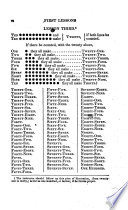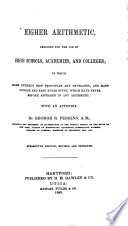 | Charles WATERHOUSE - 1844 - 228 σελίδες
...last term, and number of terms, to find tiie common difference ; or sum of all the terms. RULE. — Divide the difference of the extremes by the number of terms less 1, the quotient will be the difference. Multiply the sum of the extremes by the number of terms, and... | |
 | Horatio Nelson Robinson - 1845 - 310 σελίδες
...of the extreme terms, or mean term, by the number of terms. RULE 3. To find the common difference. Divide the difference of the extremes by the number of terms less one. RULE 4. To find the number of terms. Divide the difference of the extreme terms by the common difference,... | |
 | 1845 - 210 σελίδες
...for a farthing ? Ans. 86 L. 17 S. 10 d. CASE 2. When the two extremes and number of terms arc RULE. Divide the difference of the extremes by the number of terms, less one ; the quotient will be the common difference. EXAMPLES. 1. Twenty and sixty are the two extremes of... | |
 | George Roberts Perkins - 1846 - 266 σελίδες
...term, the last term, and the number of terms, to find the common difference, we have this • RULE. Divide the difference of the extremes by the number...one,. EXAMPLES. 1. The first term of an arithmetical progression's 5, the last term is 176, and the number of terms 58. What is the common difference ?... | |
 | 1846 - 258 σελίδες
...term, the last term, and the number of terms be ing given, to find the common difference. RULE. — (') Divide the difference of the extremes by the number of terms less 1, and the quotient will be the common difference. liiieslinn. — 1. How do you find the common difference?... | |
 | Almon Ticknor - 1846 - 274 σελίδες
...first term, the last term, and the number of terms being given, to find the common difference. RULE I. Divide the difference of the extremes by the number of terms, less 1, and the quotient will be the common difference sought. 1. The extremes are 3 and 39, and the number... | |
 | Pliny Earle Chase - 1848 - 244 σελίδες
...difference of the extremes 24, must be 8 times the common difference, which is therefore 3. RULE. \ Divide the difference of the extremes by the number of terms less one, and the quotient will be the common difference. This difference repeatedly added to the less, or subtracted... | |
 | George Roberts Perkins - 1849 - 344 σελίδες
...first term into the number of terms; divide this remainder by the product of the number of terms into the number of terms, less one. EXAMPLES. 1. The first term of an arithmetical progression is 21, the number of terms is 50, and the sum of all the terms is 3500. What is the common difference... | |
 | George Roberts Perkins - 1849 - 356 σελίδες
...this RULE. Divide the last term by the first term ; extract that root of ike quotient which is denoted by the number of terms, less one. EXAMPLES. 1. The first term of a geometrical progression is 1, the last term is 64, and the number of terms is 7. What is the ratio... | |
 | Benjamin Greenleaf - 1849 - 336 σελίδες
...will be the common difference. Thus, 27-:-9 = 3, the common difference. Hence the following RULE. — Divide the difference of the extremes by the number of terms less one, and the quotient is the common difference. EXAMPLES FOR PRACTICE. 1. The extremes of a series are 3... | |
| |